4.7 Keeping People Safe
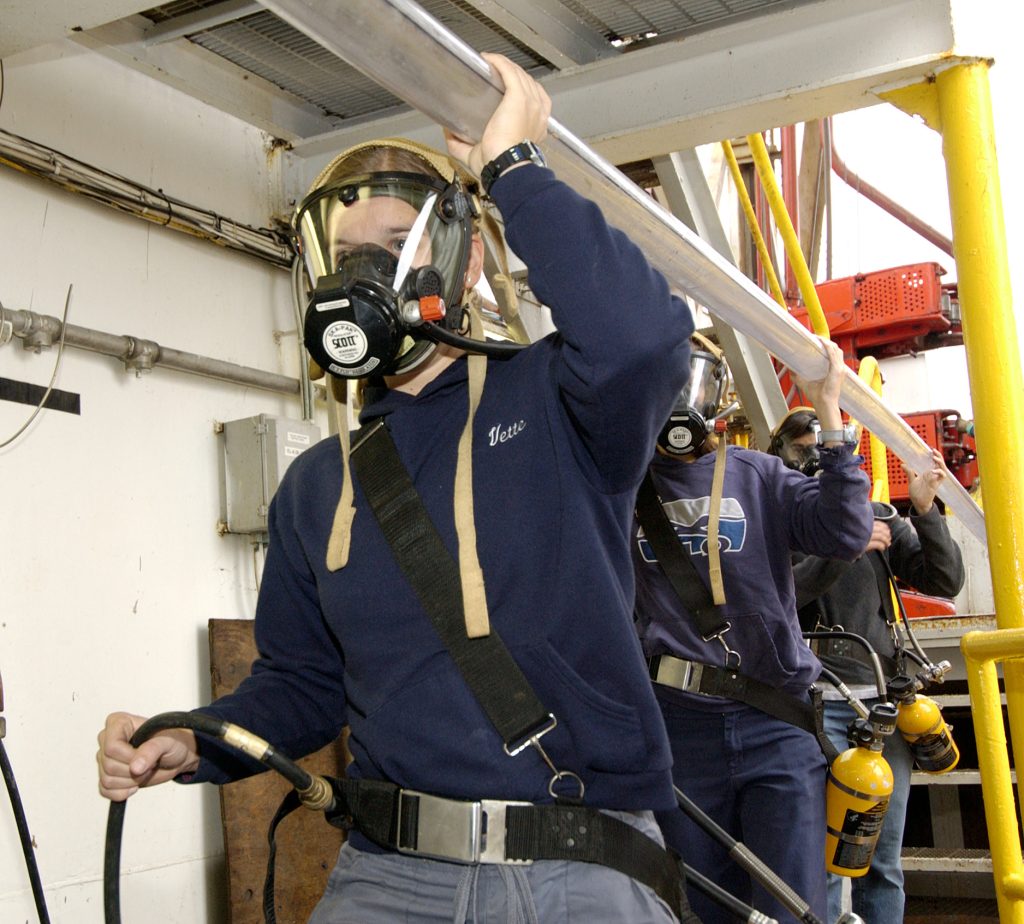
Multiple safety measures are in place to ensure that all scientists and crew at sea on research vessels are protected as they carry out their research objectives. Ships are well built to withstand the forces and conditions they are subjected to, and there is a lot of safety equipment for all kinds of emergencies on board, and procedures to prevent their necessity. Here we highlight just a handful of those safety measures that were present on JOIDES Resolution.
The Bridge crew of JOIDES Resolution was constantly monitoring the weather and coordinating with the drillers on the rig floor to determine if the conditions were safe for drilling, or if operations needed to be suspended. Wind speeds and wave height could exceed the working capacity of the ship, which would cause dangerous conditions if the safety measures that existed were not followed.
Even with the ship crew observing the physical conditions of the ocean and atmosphere at all times, there were safety features and practices in place to ensure safe operations for all on board.
Personal Protection Equipment (PPE)
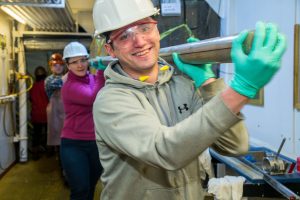
All individuals on board JOIDES Resolution had mandatory guidelines to follow when it came to ensuring they were wearing the appropriate safety gear and clothing, especially for feet, hands, eyes, head, and ears. For example, close-toed shoes were required on the ship, with steel-toed shoes or boots required in areas where operating equipment such as forklifts were taking place, or on the deck where drilling activities were underway.
Additional safety gear included: safety glasses, hard hats, ear protection, gloves, long-sleeve shirts, long pants, and/or work coveralls.
Fire Safety
JOIDES Resolution had a well-equipped and well-rehearsed Fire Rescue Team prepared for fire emergencies. The JR typically conducted weekly fire drills, even though SOLAS regulations (The International Convention for the Safety of Life at Sea) only required that fire drills be performed once a month. The weekly drills provided additional training particularly for the drill crew, who remained on the drill floor during emergencies; the drill crew members off shift then would respond as a back up fire team. In addition, there were many spaces and different types of fire fighting equipment, and the additional drills provided for more in-depth review and training.
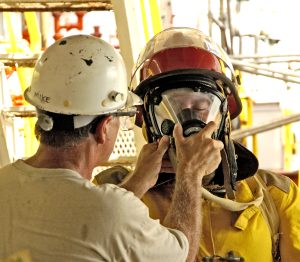
Drills at the beginning of an expedition often focused on fire suit and SCBA (Self-Contained Breathing Apparatus) donning practices. As the crew worked a schedule of two months on/two months off the ship, taking this time at the beginning of an expedition to review equipment operation would improve the speed which crew members could put on the gear (as fires grow very fast, quicker is better). Drills would be done as a fire scenario, and different spaces and types of fires would be practiced each time.
A short outline for a fire safety drill included: (a) sound the alarm; (b) muster (or gather) at designated stations; (c) radio and comms (communications) checks; (d) don equipment and proceed to the scene; (e) close ventilation (simulated or real); (f) secure power (simulated or real); (g) run out fire hoses (direct attack and boundary cooling); (h) practice a space entry in fire fighting gear, which may include a search and a simulated rescue from the space; and (i) simulate extinguishing the fire with fire extinguishers, hoses, or the CO2 system. Following or during the scenario, the fire pumps would be run and tested, and the hose teams would exercise with the hoses. When there was a personnel rescue scenario, the stretcher team would bring the stretcher, and teams would practice securing an injured person and moving them to the hospital.
Some emergency scenarios were a bit more simple and quick. For example, a drill involving the small midship fire locker would involve the following steps: (a) look to see no one is still inside; (b) close the door and the vent; (c) run through the CO2 system activation procedure; (d) check the adjacent areas; and (e) test the fire pumps. Immediately following the scenario, there would be a review to discuss the potential fire hazards, types of possible fires, other potential hazards within the space and adjacent spaces (such as the many fuel tanks), access points, ventilation, and available equipment to use for fires and personnel rescue within the space. There would also be a review of the drill to discuss what went well, and what did not.
Fun Fact – learn about the term “muster”
The term “muster” originates from military usage, meaning to assemble troops, often for inspection or preparation for battle. In a maritime context, this term signifies the gathering of crew and passengers during emergencies. It ensures that everyone is accounted for and ready to follow emergency procedures, like evacuations or safety drills. At the start of each JOIDES Resolution expedition, every crew member, technician and scientist was assigned to a muster station, and to one of the four lifeboats.
Image 1 – The Second Mate leads a fire drill simulation in the galley. After removing a glove and placing his hand near the door to detect heat in the next room, here he demonstrates how to use the door to protect yourself against the possible onrush of flames. (Credit: Bill Crawford, IODP/TAMU); Image 2 – Three-man fire hose team. (Credit: William Crawford, IODP JRSO); Image 3 – Post-fire drill debriefing in the galley with the Second Mate. (Credit: Sandra Herrmann, IODP JRSO). All images are from IODP JRSO, MerlinOne photo archive, CC BY 4.0.
Medical Doctor and Ship Hospital
One of the important initial tasks of the JOIDES Resolution doctor was to review the medical files of all the scientists accepted to sail, even after the scientists had a physical exam and were cleared for sailing from a doctor on shore. The ship’s doctor would review the medical forms, and if any issues were found, the doctor could disqualify a participant from sailing, or deem it necessary to ensure that there was a medical plan in place and any necessary medications were available during the expedition. The review also ensured that the Doctor was aware of any potential medical issues that could cause complications in onboard treatment (allergies, contraindicated medications, etc.). The JR’s crew were all required to have seaman’s medical certificates and to report any medications or physical issues to the Doctor before sailing.
After leaving port for the start of an expedition, the Doctor’s role on board ranged from helping out if someone felt seasick, had an allergic reaction, or even a really sore back from sleeping poorly. There was only one Doctor that sailed on board the ship per expedition, and they slept in a cabin next to the ship’s hospital in case there was an emergency when they were not on their 12-hour shift. Should there ever have been an issue, at any time of day, they would jump into action to diagnose, treat, and care for the individual. At times, that individual might have required more intensive medical attention because the treatment was beyond the scope of what was offered onboard. If this ended up being the case for the patient, the patient’s health took precedence, and the Doctor worked directly with shore medical support and the Captain to determine how to get the patient to a mainland hospital. Transporting a patient involved either sailing to the closest port or through an air evacuation from the helicopter pad at the stern of the ship.
Images 1 and 2 – Photos taken within the hospital on board JOIDES Resolution (Credit: Jennifer Field, EXP 395); Image 3 – The doctor also takes part in ship emergency drills. Here, one of the many doctors that has served on board JOIDES Resolution, Doctor Jeffrey Hernandez (Physician) checks muster at a weekly boat drill during Expedition 309 (Credit: IODP JRSO, MerlinOne photo archive, CC BY 4.0)
Medical Evacuations at Sea
For potential medical evacuations, the Doctor would assess the patient and provide initial treatment. For potentially complicated or serious issues, the Doctor would consult with an outside medical service such as Radio Medico for advice regarding treatment and necessity of a medical evacuation (or medivac). The doctors that rotated on board JOIDES Resolution were fully trained practicing physicians who specialized in emergency medicine. The ship’s hospital was well stocked with supplies to allow patients to be treated (such as the need for stitches) and to recuperate on board. The recovery time would involve reduced or no work for a time. If there was an increased risk to the patient by remaining on board, or better treatment available onshore, then the doctor would determine if a medical evacuation was necessary. There would typically be a conversation between the doctor and the patient to discuss the onboard treatment and potential risks, and the medivac could be done at the patient’s request. The Captain would also be involved in these conversations, mainly to keep informed and to give the order to medivac and begin the process, if needed.
Medical Evacuation by Helicopter
Take a listen to Dr. Suzanne O’Connell (Wesleyan University) describe a helicopter evacuation she witnessed while on JOIDES Resolution for Expedition 131 in 1995.
Life Rings
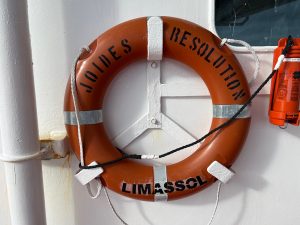
Life rings, also referred to as lifebuoys, are required on all marine vessels as an emergency flotation device to assist if anyone falls overboard. If someone were in the water, a life ring would be thrown to them. The central opening in the ring makes it easier for someone to grab on to the object during a rescue. The ring has a line attached as a way to keep the ring connected to the ship so it can be pulled in closer. There were multiple life rings lining the outside decks on all sides of JOIDES Resolution.
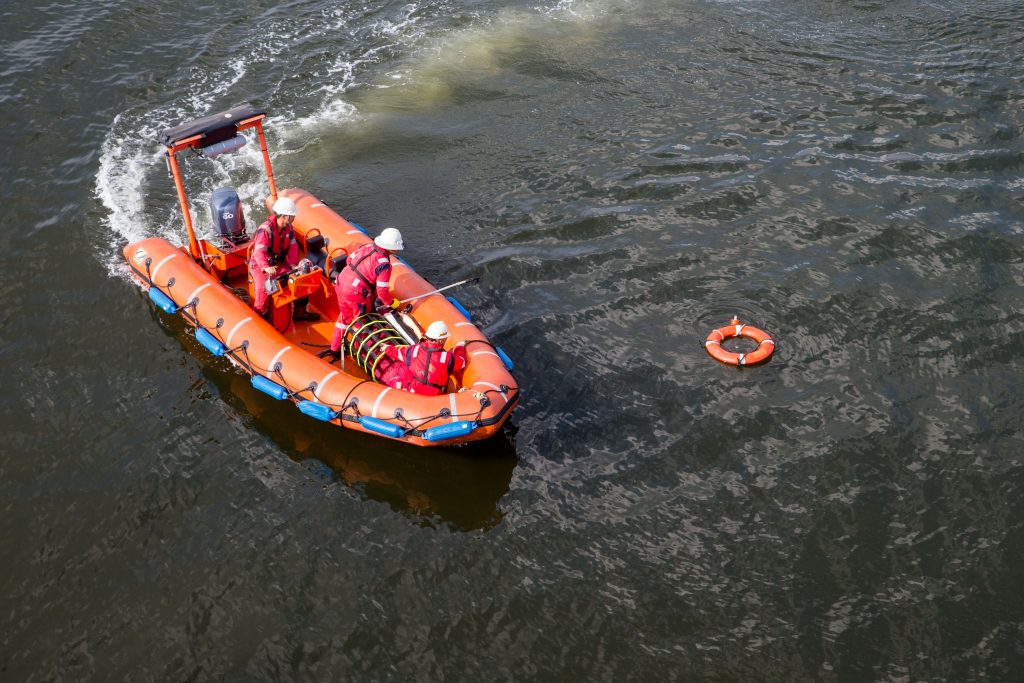
Life Jackets
Like life rings, life jackets are another piece of emergency gear required on all marine vessels. Individuals sailing on JOIDES Resolution were provided a life jacket in their cabin to utilize during drills and if there was an emergency situation. Additional life jackets were stored in bins near the life boats, if someone was not able to retrieve their assigned life jacket.
When secured around the neck and strapped around the body as shown in the image below, a life jacket will not only prevent a person from drowning, a person in the water will be automatically be flipped on their back and have their face looking to the sky. This keeps the nose and mouth free from being submerged in water and open for breathing.
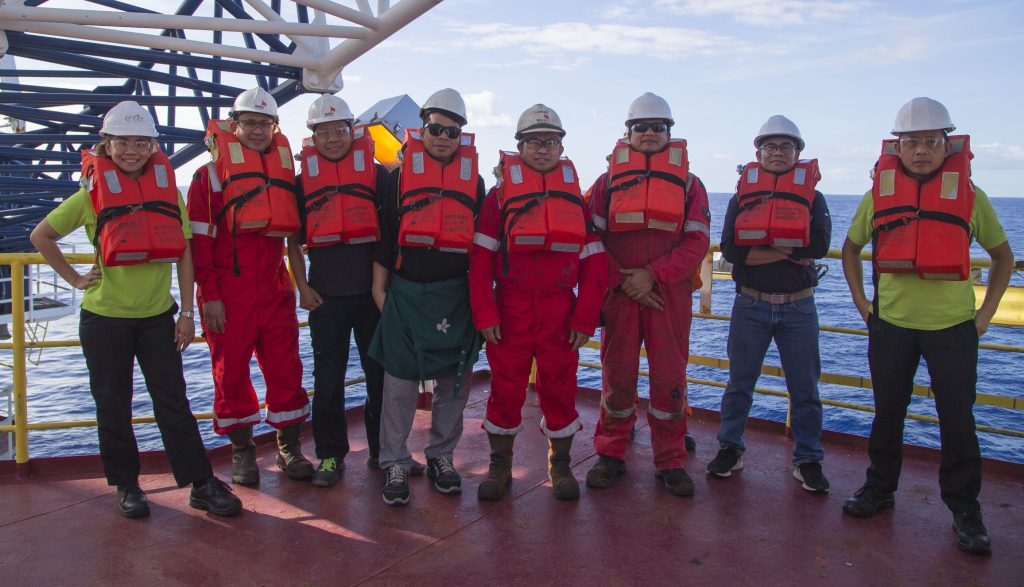
Survival Suits (aka “Gumby Suit”)
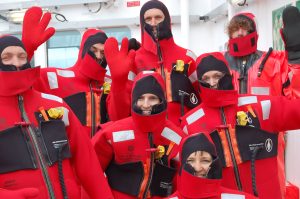
Survival suits, also called immersion suits, are designed to keep one afloat and warm to survive longer in the cold ocean water in the case of an abandon ship situation. Made out of neoprene, the suit covers one from head to toe to minimize body heat exchange with the elements to delay the onset of hypothermia. Only a small portion of the face is exposed. These suits are nicknamed Gumby Suits after the 1960s claymation/cartoon character Gumby which had mitten hands and large boot feet.
One of the first tasks an individual did when boarding JOIDES Resolution was to determine the size suit best for their height and body weight (there were three different types of suits to select from). Crew members from the ship would discuss and demonstrate how to put on the suit, then require the scientists to each practice putting on their assigned suit. There were more than enough survival suits for each crew member to have their own which remained in their cabin during the two-month expedition. In case of an abandon ship drill, one would bring their survival suit in addition to their life jacket, hard hat, and safety glasses to their muster station. In the event of an actual abandon ship emergency, one would wear the immersion suit before entering the life boats.
Tips for putting on an immersion suit
Read through the experience of a member of the science party on JOIDES Resolution for Expedition 403, as he was going through a safety drill and trying on an immersion suit for the first time. From the article The Last Hunt for the Future in Oceanographic Magazine (published online, July 2024):
“You should take your boots off; boots will tear that suit apart,” the Captain says to me as I pull a thick red immersion suit up to my chest. Resembling a full-body wetsuit, only much thicker and more claustrophobic, the suit is designed to keep you alive long enough to be rescued in water temperatures below 40 degrees. Before the zipper made its way to my nose to seal me in fully, the captain says: “But don’t forget your boots; stick them in your suit (gesturing to tuck them in near my chest) before you zip it up if you were to survive long enough to wash onto a rocky outcropping you would be glad you had those.”
I think he saw the look of concern on my face and followed up with: “This entire exercise is only a precaution for an extremely unlikely event.” His attempt at being polite was only a further reminder of how remote Arctic waters can be.
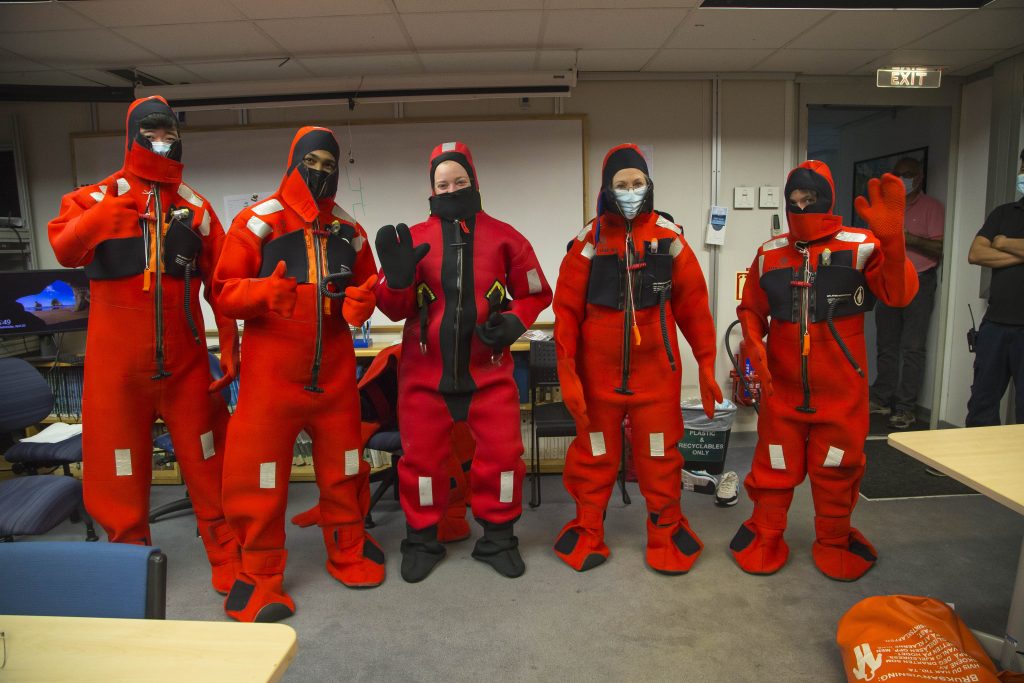
Safety by the numbers! Try your best to match the items below.
LifeBoats
The JR operated in locations where immediate assistance was unavailable, some locations more remote than others. As a result, the ship was equipped with several emergency communication features and four bright orange, fully enclosed, motorized lifeboats.
In response to RMS Titanic sinking in 1914, the International Convention for the Safety of Life at Sea (SOLAS) was adopted. SOLAS requires that lifeboats on a single side of a vessel be able to accommodate all passengers. This ensures that if one side of the vessel is disabled or off-limits, all crew members can fit into the two boats on the other side. For JOIDES Resolution, each lifeboat could carry 70 persons, so two lifeboats on each side of the ship could easily accommodate the maximum 120 scientists and crew members on the expeditions.
The lifeboats were designed to handle rough seas and high waves. Because time is critical in an emergency at sea, the boats were designed to release rapidly into the water. Each boat was equipped with signal equipment, first aid kits, oars in case the engine fails, a life ring, and a two week supply of emergency rations and water for each person. During each two-month expedition, everyone on board participated in weekly emergency drills. The lifeboat engines were also tested weekly for at least three minutes.
Watch this video to learn more about the operation and equipment on JOIDES Resolution’s lifeboats.

